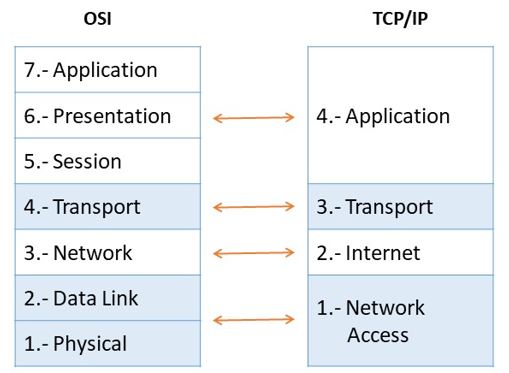Today’s most popular protocol in use is the Transmission Control Protocol/Internet Protocol (TCP/IP). Currently, the Internet and most enterprise intranets use TCP/IP because of its popularity, flexibility, compatibility, and ability to deploy on large and small networks. Although TCP/IP is the most widely used protocol, it is not the easiest to configure or even understand.
The TCP/IP model consists of four layers instead of the seven of the OSI model. The four layers of the TCP/IP model correlate to the seven layers of the OSI model, but layers of the TCP/IP model combine several layers of the OSI model.
When discussing the different protocols in the IP stack, the layers of the OSI and TCP/IP models are interchangeable. In other words, the Internet layer and the network layer describe the same thing, just as the transport layers, the other two layers of the TCP/IP model are composed of multiple layers of the OSI model.
TCP/IP is open-source; its standards and protocols are defined in a public forum through the IETF (Internet Engineering Task Force (IETF)) and published by RFC (Requests for Comments).
The sending of a message through the layers varies according to its direction, i.e., the source message has to start from the upper layer to the lower one, and when it reaches its destination, it begins from the lower layer to the upper one.
The layers of the TCP/IP model:

As we can see in the figure above, the presentation and session layers are not in the TCP/IP model. Also, note that the network access layer in the TCP/IP model combines the functions of the data link layer and the physical layer of the OSI model.
The TCP/IP model describes the functionality of the protocols that comprise it and how they interact through its different layers as they travel from source to destination.
When a message is sent over the network, each TCP/IP model layer adds a header with the necessary information for the destination to interpret it. This process is commonly called encapsulation. Each layer encapsulates a section of data called PDU (protocol data unit). During encapsulation, each layer encapsulates the PDUs of the previous layer according to the necessary protocol.
The message is encapsulated with its corresponding PDU by each layer when the message is sent. The bits are sent through the medium, and the destination decapsulates and reads each of the PDU’s starting from the lower layer until it reaches the upper layer.
The PDUs used in the TPC/IP model are:
- Data: general term for the PDUs used in the application layer.
- Segment: transport layer PDU.
- Packet: Internet layer PDU
- Frame: PDU of the network access layer.
- Bits: a PDU used when physically transmitting data over a medium.
Each of the layers of the TCP/IP model is explained below.
Layer 4. Application Layer
The application layer is the top layer of the TCP/IP model; the application layer defines the TCP/IP application protocols and how host programs interact with the transport layer services to use the network.
The application layer includes all higher-level protocols such as DNS, HTTP, Telnet, SSH, FTP, TFTP, SMTP, DHCP, X Window, RDP, etc.
Layer 3. Transport Layer
The Transport Layer is the third layer of the TCP/IP model, the purpose of the transport layer is to allow source and destination host devices to carry on a conversation. The transport layer defines the level of service and the state of the connection used to transport the data.
The main protocols included in the transport layer are TCP (Transmission Control Protocol) and UDP (User Datagram Protocol).
Layer 2. Internet Layer
The Internet Layer is the second layer of the four-layer TCP/IP model. The Internet layer provides the source and destination address information (logical address or IP address) to forward data between hosts across the network; the Internet layer is also responsible for routing IP datagrams.
The main protocols included in the Internet layer are IP (Internet Protocol), ICMP (Internet Control Message Protocol), ARP (Address Resolution Protocol), RARP (Reverse Address Resolution Protocol), and IGMP (Internet Group Management Protocol).
Layer 1. Network access layer
The network access layer, also known as the medium access layer, is the first layer of the TCP/IP model. The network access layer defines how data is physically sent across the network, including how bits are signaled and sent by physical devices (hardware) that interact directly with a network medium, e.g., a coaxial cable, fiber optics, twisted-pair copper cable, wirelessly, etc.
The protocols included in the network access layer are Ethernet, Token Ring, FDDI, X.25, Frame Relay, among others, the most popular being Ethernet.